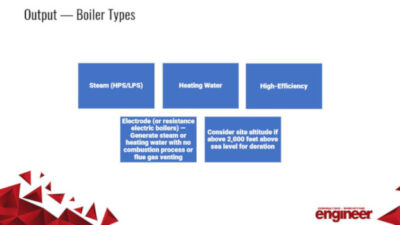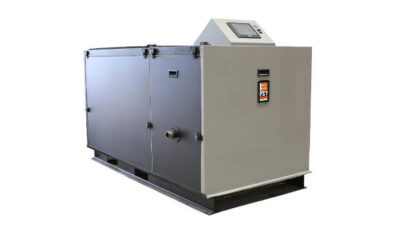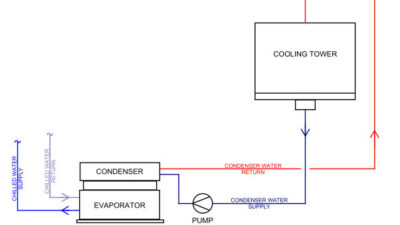Waste-heat recovery systems are increasingly used in buildings to move waste heat from laboratories, data centers, or industrial activities to provide beneficial heating in other parts of the building.
Learning Objectives:
- Know the basics of waste-heat recovery.
- Learn the codes, standards, and guidelines that provide engineers with guidance in designing waste-heat recovery systems in buildings.
- Understand that recovering waste heat becomes an attractive option for facilities working to achieve low energy use (such as in high-performance buildings) and to reduce emissions.
Space heating is the single largest energy end use in most building types. The surprising fact is there is a lot of waste heat that goes unused. Hospitals and laboratories are two of the highest energy-use-intensity building types. Regardless as to whether a conventional hospital or lab is in Miami or New York City, the largest single energy consumer is the heating plant. This is because the heating load in hospitals and labs is largely reheat, which is not a climate-dependent load. Traditional, centralized HVAC systems with code-required air-change rates typically use reheat to keep the spaces comfortable. Any heat that can be recovered in these building types can be used to reduce the heating energy.
For many engineers, their first foray into heat-recovery comes as a result of a code requirement. ASHRAE Standard 90.1: Energy Standard for Buildings Except Low-Rise Residential Buildings and the International Energy Conservation Code (IECC) both have requirements for heat recovery. The most stringent being the mandatory requirement of energy-recovery ventilation (ERV) systems in the 2012 and 2015 versions of the IECC.
For example, a system with 35% outside air at maximum flow that has greater than or equal to 5,500 cfm total supply is required to have an ERV in climate zones 1A, 2A, 3A, 4A, 5A, and 6A under the 2012 and 2015 IECC. (The 2015 IECC clarifies it further by separating systems that operate greater than and less than 8,000 hours/year.)
ASHRAE 90.1’s ERV requirement is similar but prescriptive, which means the performance path allows the ERV performance to be made up in other systems. The other most common code-required heat recovery is a prescriptive requirement introduced in ASHRAE 90.1-1999 and the 2003 IECC, which is applied for recovering condenser heat of water-cooled systems to preheat service hot water in 24-hour facilities or provide reheat (via an exception). This requirement has remained in all subsequent versions of ASHRAE 90.1 and the IECC.
The first step in any design process is to focus on reducing the load before employing technologies to serve the load or offset energy consumption. Reducing the load saves on first cost and lifecycle cost, whereas systems used to just reduce energy consumption add to the first cost while reducing lifecycle cost. Energy models may be used to compare load-reduction strategies early in design.
Defining waste-heat recovery
Waste-heat recovery is using any heat that would otherwise be wasted. There are several media within building systems from which heat can be recovered:
- Air
- Water
- Refrigerant.
Air heat-recovery systems are most often employed to preheat and/or precool ventilation air to reduce the load. Some heat-recovery ventilators, often also referred to as ERVs, have wheels that spin between two airstreams to transfer heat. Others have cross-flow static cores. The three main types of wheels are enthalpy (also known as total energy), sensible-only, and desiccant. Enthalpy wheels transfer both sensible and latent heat between the airstreams. These often use the building exhaust air as the second airstream. Sensible-only wheels preheat/cool but don’t provide any transfer of moisture between airstreams.
The primary purpose of desiccant wheels is to reduce the dew point of the supply air by removing moisture and heating it. They are made of a hygroscopic material, such as silica gel or lithium chloride, that adsorbs moisture from the supply airstream and rejects the moisture via a hot regeneration airstream to the ambient. Cross-flow heat-recovery cores work similar to enthalpy wheels, but the airstreams flow in an X pattern separated by static plates of heat-transfer media. Static cores can be enthalpy or sensible-only depending on the heat-transfer media used for the plates.
Mechanical codes don’t allow heat recovery from exhaust that is considered hazardous. Run-around coils and heat pipes can both be used to recover heat from contaminated airstreams because both allow for completely separate airstreams without the possibility of any cross-contamination. A run-around coil uses two coils connected by pipe with a pump to circulate a heat-transfer fluid, which is often a glycol brine in cold climates. Another advantage specific to the run-around coil is it allows the two airstreams to be much farther apart, but pumping energy is required and results in piping heat loss. Newer versions of run-around loops that integrate the heating- and cooling-water systems and sophisticated controls have improved the performance of run-around loops.
Heat pipes work similar to run-around coils, but use refrigerant as the heat-transfer medium. This allows the pumping energy to be eliminated by the phase change of the refrigerant. Heat pipes are more limited in their arrangement as compared with run-around coils, though. All of these air-side heat-recovery technologies can be used in multiple configurations. For instance, a heat pipe or run-around coil can be set up to precool air before it enters the cooling coil and transfer that heat to after the cooling coil for free reheat. Some units even have two wheels, where an enthalpy wheel is used to precool and dehumidify the air before the cooling coil and a sensible-only wheel is used to reheat the air after the cooling coil but before any heating coils.
The sensible-only wheel could be used second in sequence with a supply-air temperature (SAT) reset to reduce reheat. SAT resets are required by code but often aren’t effective in labs and hospitals because a critical zone forces the system to stay at the minimum SAT.
Water or hydronic heat-recovery systems reuse heat produced by the cooling process that would be rejected by a cooling tower or condenser. Depending on the building systems and their relative loads, the recovered heat could be used to preheat a low-temperature heating hot-water loop or a service hot-water loop. Not only does this reduce the heating energy needed, but it also reduces the cooling tower fan energy used to reject the heat as well as condenser pump energy.
Heat-recovery chillers are designed to produce chilled water (CHW) and hot water (HW). They can even be set in heating mode to maintain a certain leaving HW temperature while letting the leaving CHW temperature float based on load. Heat-recovery chillers give the most benefit when they can run continuously at full load to maximize the heat-recovery hours, such as when they have been sized for the constant minimum-cooling load in a hospital.
Energy models are useful for determining the diversified minimum building load for heat-recovery chiller sizing; otherwise, they can be oversized due to exaggerated process loads or lack of consideration for diversity. A whole-building energy simulation is the only way to get a full picture of how the building reacts to its internal loads and environment. Heat-recovery chillers can even be coupled with thermal storage to expand the hours of useful heat recovery in building types with fewer hours of coincident heating and cooling loads.
Hydronic heat recovery can be used with most water-cooled equipment. Air-cooled chillers can even have a hydronic heat-recovery bundle added. Water-source heat pumps (WSHPs) use an hydronic condenser loop, but heat recovery works a little differently. One condenser-water loop can have multiple WSHPs in heating or cooling mode. Some reject heat to the condenser-water loop while others receive heat from the condenser-water loop, so the WSHPs in heating mode are essentially receiving heat from the cooling mode.
Refrigerant system heat recovery is similar to hydronic systems. Hot-gas reheat is a common type of heat recovery often employed in dedicated outside-air systems (DOAS). The hot gas from the outlet of the direct-expansion cooling coil bypasses the condenser and is used as free reheat to both decrease the relative humidity (RH) of the supply air (SA) and reduce the possibility of overcooling when in dehumidification mode. Hot-gas reheat is an efficient strategy anytime dehumidification is dominant or a neutral to warm SA temperature is desired, such as in natatoriums where there is a constant dehumidification load and the space set point is around 80°F. Specialized pool dehumidification units can also use the recovered heat for pool heating.
Variable refrigerant flow (VRF) systems come in two types, heat-recovery and heat pump. Only heat-recovery VRF systems allow for simultaneous heating and cooling on the same refrigerant loop. The simultaneous heating and cooling feature is possible by using recovered heat based on the predominant mode of operation (heating or cooling). Like with a WSHP, the VRF fan coil units (FCUs) in cooling mode reject heat, in the form of hot vaporized refrigerant, back to the common loop, but heat-recovery VRF systems allow that hot gas to first be used by any FCU calling for heat. The opposite occurs when heating is the predominant mode. Even though heat recovery works similarly between hydronic and refrigerant systems, refrigerant systems have the advantage of not needing pumps.
Five tips for using energy recovery
- Check what is required by code.
- Specify a bypass with air-side energy recovery.
- Size heat-recovery chillers to run continuously at full load.
- Zone variable refrigerant flow systems to take maximum advantage of heat recovery.
- Use energy models to determine the most efficient heat-recovery strategy.
Cory Duggin is the energy-modeling wizard at TLC Engineering for Architecture Inc., providing building-performance simulation efforts across the 375-plus-person firm through both direct project involvement and by supporting project teams on specific and unique modeling issues. He is a member of the Consulting-Specifying Engineer editorial advisory board.



